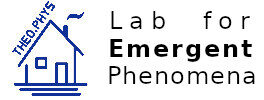Research
research interests
One of the central paradigms in modern science is to focus on collective behaviour and organising principles. In many scientific disciplines ranging from natural to social sciences it is a key issue to understand the complex behaviour of many entities compared to the properties of a single one, e.g., besides many others, in studying the climate of the earth, our brain, in investigating swarm intelligence, in predicting changes in our society or trends in financial markets. In short, this can be expressed by „more is different“.
The collective behaviour of matter as well as its interplay with light is therefore one of the most important topics of modern science. Understanding it is crucial in basic research, as it holds the key to a variety of correlated many-body states – realised for example in spin liquids or superconductors. At the same time, it is clear that this understanding forms the basis for many (quantum) technological applications which define the modern era. In particular, it is decisive to gain a systematic understanding of collective phenomena in order to identify fundamentally new behaviour.
My general research interests are emergent collective phenomena of quantum many-body systems which are relevant for condensed matter physics, atomic physics, and quantum information. Interactions between various degrees of freedom lead to novel states of matter with fascinating properties and interesting collective properties. Furthermore, it is an important aspect of my research to develop modern theoretical tools to treat microscopic models of correlated systems in order to predict and to pinpoint emergent quantum phenomena in real systems.
correlated light-matter quantum systems
We are interested in light-matter systems, where strong matter-matter and strong light-matter interactions are present simultaneously. From a condensed matter perspective one might expect to tune the properties of quantum materials by quantum light and from a quantum optics perspective one might engineer interesting novel facets of quantum light originating from such entangled light-matter systems. We investigate the influence of light-matter interactions on correlated quantum matter by studying microscopic models like the paradigmatic Dicke-Ising model and its generalizations but also dense cold atomic clouds of Dysprosium atoms and light-matter interactions in electronic Mott insulators.
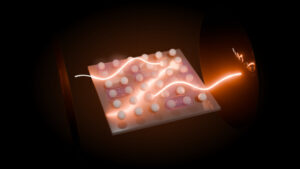
In the Dicke-Ising model, the light-matter interaction to a confined, spatially delocalized bosonic light mode, such as provided by an optical resonator, resembles a quantized transverse magnetic field of tunable strength. As a consequence, the symmetry-broken magnetic state breaks down for strong enough light-matter interactions to a paramagnetic state. The nonlocal character of the bosonic mode can change the quantum phase transition in a drastic manner, which we analyze quantitatively. The results show a direct transition between a magnetically ordered phase with zero photon density and a magnetically polarized phase with superradiant behavior of the light.
References
[1] Physical Review Research 2, 023131 (2020)
[2] arXiv:2306.11486 (2023)
[3] Physical Review B 109, 085149 (2024)
[4] arXiv:2402.15209 (2024)
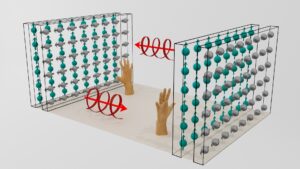
Quantum metasurfaces, i.e., two-dimensional subwavelength arrays of quantum emitters, can be employed as mirrors towards the design of hybrid cavities, where the optical response is given by the interplay of a cavity-confined field and the surface modes supported by the arrays. We show that, under external magnetic field control, stacked layers of quantum metasurfaces can serve as helicity-preserving cavities. These structures exhibit ultranarrow resonances and can enhance the intensity of the incoming field by orders of magnitude, while simultaneously preserving the handedness of the field circulating inside the resonator, as opposed to conventional cavities. The rapid phase shift in the cavity transmission around the resonance can be exploited for the sensitive detection of chiral scatterers passing through the cavity. We discuss possible applications of these resonators as sensors for the discrimination of chiral molecules.
References
[1] Optica Express 31, 6003 (2023)
[2] Physical Review Letters 132, 043602 (2024)
topologically ordered quantum systems
Topologically-ordered quantum phases represent a class of two-dimensional ground states where elementary properties such as the ground-state degeneracy depend on the topology of the system. Elementary excitations above such a ground state carry fractional quantum numbers and obey an exotic statistics which is neither fermionic nor bosonic. Such particles are called anyons where one distinguishes Abelian and non-Abelian anyons. The latter are the central objects for the field of topological quantum computation.
The concept of topological order is theoretically and experimentally relevant for the fractional quantum Hall effect, for the class of topological insulators, for graphene, and for quantum magnetism. In recent years we have for the first time developped a true quasi-particle picture for Abelian as well as non-Abelian anyons. This allows the characterization of topological quantum phase transitions. Currently we are working on the robustness of three-dimensional topological order including fracton phases.

The quantum robustness of fracton phases is investigated by studying the influence of quantum fluctuations on the X-Cube model and Haah’s code, which realize a type-I and type-II fracton phase, respectively. To this end, a finite uniform magnetic field is applied to induce quantum fluctuations in the fracton phase, resulting in zero-temperature phase transitions between fracton phases and polarized phases. Using high-order series expansions and a variational approach, all phase transitions are classified as strongly first order, which turns out to be a consequence of the (partial) immobility of fracton excitations. Indeed, single fractons as well as few-fracton composites can hardly lower their excitation energy by delocalization due to the intriguing properties of fracton phases, as demonstrated in this work explicitly in terms of fracton quasiparticles.
References
[1] Physical Review B 101, 054426 (2020)
[2] SciPost Physics 12, 069 (2022)
[3] Physical Review Research 6, 013191 (2024)

We study the robustness of intrinsic topogical order in two and three dimensions under external perturbations by investigating the paradigmatic toric code in an external field. Exact dualities, series expansions, quantum Monte Carlo simulations as well as variational calculations reveal ground-state phase diagrams with first and second-order quantum phase transitions.
References
[1] SciPost Phys. 6, 078 (2019)
[2] Physical Review B 102, 214422 (2020)
[3] Physical Review B 105, 184425 (2022)
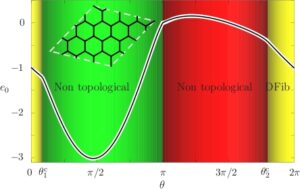
We examine the zero-temperature phase diagram of the two-dimensional Levin-Wen string-net model with Fibonacci (see left figure) and Ising anyons in the presence of competing interactions. Combining high-order series expansions and exact diagonalizations, we find that the non-Abelian topological phases can be separated from nontopological phases by second-order quantum critical points, the positions of which are computed accurately. The evaluation of critical exponents suggests unusual universality classes.
References
[1] Physical Review Letters 110, 147203 (2013)
[2] Physical Review B 89, 201103(R) (2014)
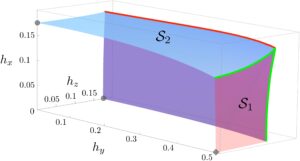
We investigated the stability of the topological phase of the toric code model in the presence of a uniform magnetic field. The corresponding phase diagram is shown on the left [3]. We find that when this perturbation is strong enough, the system undergoes a topological phase transition whose first- or second-order nature depends on the field orientation. When this transition is of second order, it is in the Ising universality class except for the special red line on which the criticality is different, since charges and fluxes condense simultaneously.
References
[1] Physical Review B 79, 033109 (2009)
[2] Physical Review B 80, 081104 (2009)
[3] Physical Review Letters 106 107203 (2011)
[4] arXiv:2401.06507 (2024)
[5] arXiv:2402.15389 (2024)
quantum magnets with long-range interactions
There are many important quantum systems where long-range interactions are relevant. Important examples are dipolar interactions between spins in spin-ice materials giving rise to emergent magnetic monopoles, effective long-range magnetic interactions between
zigzag edges in graphene, and especially trapped cold-ion systems in quantum optics for which the nature of interactions can be varied flexibly. The paradigmatic model in this context is the transverse-field Ising model with algebraically decaying Ising interactions.

We study the critical breakdown of two-dimensional quantum magnets in the presence of algebraically
decaying long-range interactions by investigating the transverse-field Ising model on the square and
triangular lattice. This is achieved technically by combining perturbative continuous unitary trans-
formations with classical Monte Carlo simulations to extract high-order series for the one-particle
excitations in the high-field quantum paramagnet. We find that the unfrustrated systems change from mean-
field to nearest-neighbor universality with continuously varying critical exponents. In the frustrated case on
the square lattice the system remains in the universality class of the nearest-neighbor model independent of
the long-range nature of the interaction, while we argue that the quantum criticality for the triangular lattice
is terminated by a first-order phase transition line.
References
[1] Physical Review B 94, 075156 (2016)
[2] Physical Review Letters 122, 017203 (2019)
[3] Physical Review B 100, 144411 (2019)
[4] Physical Review B 102, 174424 (2020)
[5] Physical Review B 103, 245135 (2021)
[6] SciPost Physics 13, 088 (2022)
[7] SciPost Physics 15, 087 (2023)
[8] arXiv:2311.10632 (2024)
[9] arXiv:2402.10584 (2024)
[10] arXiv:2403.00421 (2024)
interacting electronic systems
The Hubbard model represents one of the most studied microscopic models in condensed matter physics. On a very simple level it describes the interplay between the kinetics and the Coulomb interaction of electrons in solids. Despite its simplicity, it displays a very rich phase diagram and it is very important for the microscopic modelling of many condensed matter materials.
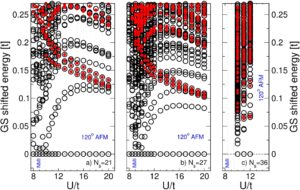
One particular intriguing aspect is the interplay between strongly correlated fermionic degrees of freedom and geometrical frustration of the underlying lattice topology. In the past years there are more and more evidences for the existence of insulating but non-magnetic intermediate phases with exotic properties at half filling. Experimentally, this is for example relevant for a class of organic superconductors which can be understood in terms of a Hubbard model on an anisotropic triangular lattice. We developped efficient tools to derive effective spin models which describe the Mott phase including the fascinating non-magnetic phases in a quantitative fashion. Recently, we derived the relevant low-energy model for the Hubbard model on the isotropic triangular lattice and we showed that it comprises a non-magnetic intermediate phase. These are the first quantitative calculations which suggest the existence of a spin-Bose metal in a two-dimensional model of interacting electrons.
References
[1] Physical Review Letters 105, 267204 (2010)
[2] New Journal of Physics 14, 115027 (2012)
[3] Physical Review Research 2, 023098 (2020)
effective models – development of theoretical tools
For many problems we have applied and develop the method of perturbative continuous unitary transformations (pCUTs) as well as other linked cluster expansions. In essence, such techniques provides analytical effective low-energy models in the thermodynamic limit up to high orders in a small parameter. The knowledge of a high-order series expansion allows in many cases to determine non-perturbative properties like critical points and critical exponents.

Non-perturbative extensions of the pCUT method would be very helpful. In practice, such extensions are often problematic since uncontrolled truncations of the flow equations lead to divergencies of the flow. Recently, we developped a robust non-perturbative scheme for gapped quantum phases. The essential idea is to combine continuous unitary transformations and graph theory.
References
[1] European Physics Letters 94, 17004 (2011)
[2] New Journal of Physics 14, 115027 (2012)
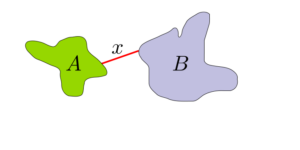
We identify a fundamental challenge for non-perturbative linked cluster expansions (NLCEs) resulting from the reduced symmetry on graphs, most importantly the breaking of translational symmetry, when targeting the properties of excited states. A generalized notion of cluster additivity is introduced, which is used to formulate an optimized scheme of graph-based continuous unitary transformations (gCUTs) allowing to solve and to physically understand this fundamental challenge. Most importantly, it demands to go beyond the paradigm of using the exact eigenvectors on graphs.
Reference:
[1] European Physics Letters 110, 20006 (2015)
[2] arXiv:2303.04774 (2023)
topics and methods
|
|
|
|
|
|
|
|
|
|
|
|
|
|
